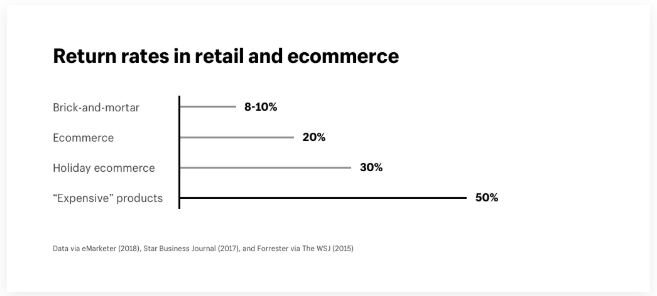"Consumers now expect delivery to be fast, reliable and free. Click and collect has become a prerequisite and shoppers have come to expect free returns. The customer has never had it so good – but this has added a lot of cost and complexity for retailers." – Retail Dive
The very nature of online retail is conducive to the occurrence of returns: the ease of the shopping experience combined with buying without trying inevitably leads to consumers exchanging or returning products. And returns are notably more frequent during the holiday season. The impact of this phenomenon should not be underestimated: excessive returns dearly affect supply chains as well as profit margins.
But just how frequent are online shopping returns? Why do they happen in the first place? Is it possible to profit from this process?
“Retailers are not very good at managing returns right now, and so unless they invest in their ability to manage returns, the volume of returns coming back will cause problems in their overall supply chain,” said Tom Enright, supply chain research director at Gartner.”- CNBC
Let’s crunch some numbers
Global Web Index research pointed out that consumers actively seek return policy information before committing to a purchase. People are genuinely concerned about the ability of returning an item if they’re not happy with it.
“In the U.S. alone, Statista estimates return deliveries will cost $550 billion by 2020, 75.2% more than four years prior. Worse, that number doesn’t include restocking expenses nor inventory losses. Nailing down exact numbers on return rates is notoriously difficult, but compiled data from separate sources paints a bleak portrait, especially for online retailers” – Shopify
Data via eMarketer (2018), Star Business Journal (2017), and Forrester via The WSJ (2015)
According to a survey conducted by Oracle Retail (reported by Retail Dive), 70% of consumers expect to return at least a portion of their holiday gifts this season. To make their returns, 65% of respondents said they would go to the store, while 32% said they would return items by mail.
Why do customers return merchandise?
By now you are wondering if people are just getting really bad at gift picking, aren’t you? While there might be some merit to your musings, the ease and freedom of the return process is the real culprit. For example, consumers have grown accustomed to ordering the same product in multiple options with the intention of only keeping one.
A survey from e-commerce platform Yotpo reported that 88% of online apparel shoppers have returned purchased items in the past year. Of those shoppers, 51% have returned between $50 and $500 worth of merchandise.
“With free returns, consumers will happily order several sizes with the intention of returning the ones that don't fit. Retailers are digging themselves a hole and it's only going to get worse as 'try before you buy' takes off. By cutting out that last point of friction – paying for everything up-front – retailers are proactively encouraging shoppers to return more." - Retail Dive
Whilst there is truth to this quote, according to a report from retail management firm Brightpearl, 32% of shoppers say they'll abandon an online purchase without an offer of free returns. A Walker Sands report (below) places free return as the second key factor determining a consumers’ online purchasing decision:
Clearly, if brands don’t offer free returns (or – heavens forbid – free shipping) they risk being shunned by consumers. After all, there’s plenty of alternatives out there for shoppers to choose from…
Driving profit through returns?
"I think what organizations are recognizing now is that the reverse logistics supply chain is a significant market opportunity for them. It used to be just an aftermarket and a cost of doing business — now it’s a revenue source or a potential revenue source." – Supply Chain Dive
Offering BORIS (Buy Online; Return in Store)
BORIS is an extremely convenient service for customers and can create stronger brand affinity, since it takes the hassle out of return shipping. An estimated 83% of shoppers prefer to return items to physical stores, regardless of whether they purchased the item online or in-store.
The biggest advantage of offering BORIS is that customers who make in-store returns often are persuaded to exchange instead or even making additional purchases, offsetting and sometimes exceeding the cost of returns. According to TotalRetail, 85% of shoppers have made an additional in-store purchase when they collected items they purchased online, with 15% saying that they do so “somewhat frequently.”
How you decide to handle your BORIS transactions depends on many things, including the type of products you sell, your store size and warehouse availability. The ultimate question is: when e-commerce returns come into your store, how will you prevent shrinkage? ApprissRetail enlisted the following considerations:
Will you use online returns to restock your store, or will they go to a distribution centre?
Would you be able to determine if another store needs that item or is low on stock and transfer it to them?
Do you have a strategy for items that do not have a home in your brick-and-mortar stores (such as only-online furniture)?
What will you do if shipping the item back to the warehouse isn’t cost-effective, but you also do not want to turn these products into clearance items that take up space in your physical stores?
Will fulfill-from-store work with your ecommerce returns?
Regardless of which strategy you choose, you’ll need the right technology to promote a seamless customer experience, as well as ensure inventory doesn’t get spoiled. Sophisticated omnichannel inventory management technology needs to be in place to provide staff with visibility of orders, up-to-date stock levels
In-store fulfilment
“Brick-and-mortar retailers are feeling the pressure of an increasingly aggressive e-commerce market. However, they can certainly provide consumers with a seamless brand experience and leverage their stores to offer the convenience and speed that formidable competitors promise.” – Digitalist Magazine
Retailers are thinking outside of the warehouse box and are looking to their brick-and mortar stores to function in ways formerly limited to distribution centres. In-store fulfilment is the ability to fulfil an order — no matter its origin — from a brick-and-mortar store. Retailers could equip their shop staff to reinstate returned items into their inventory in such way that they could be quickly resold in-store or online.
“Those that say that brick-and-mortar retailers are on their way out aren’t looking at the bigger picture. The reality is that brick-and-mortar retail is evolving in response to changes in the market.” - TotalRetail
However, there are a lot of considerations and crucial components of successfully implementing in-store fulfilment and providing a consistent omnichannel experience. Shipping from store requires that retailers cope with having packing tables, packing materials, and everything else that goes with fulfilling orders – within the cramped space of their stock room.
Moreover, these companies will need a retail order management system that integrates with POS, e-commerce and ERP. Additionally, effectively supporting order fulfilment in an omnichannel retail store environment requires the optimisation of fulfilment processes, real-time inventory visibility, and systematic returns management.
“An in-store fulfilment solution offers huge benefits to a retailer in terms of efficiency, accuracy and speed. Standardized processes and centralized systems ensure better communication; greater inventory visibility means faster, more accurate fulfilment; and a labour force that can move more efficiently will fulfil an order faster while preserving the brand-right, in-store experience. These three areas form a foundation for a superior customer experience, no matter the channel.” - Apparel
Despite the challenges involved in implementing it, offering in-store fulfilment can create a powerful competitive advantage. Businesses using this strategy to drive profit through returns will need a robust solution to support their supply chains. We will discuss this in the next section.
The key to unlocking return profits
Fulfilment tecnology
Some retailers simply aren’t equipped to handle the extra influx of returns online shopping generates: in-store or in their warehouses.
Intermec found 52% of DC managers don’t have the ability or resources to determine whether returned items should be sent to the vendor, moved into inventory, or discarded. These goods are consequently unrecognized as current inventory, getting virtually – and avoidably – wasted.
“The Reverse Logistics Association explains that managing the “return and repair” process accounts for 10% of total supply chain costs. But, if the supply chain gets stuck (due to inefficient processes), it can compound and reduce profit by 30%.” - Shopify
The issue of returns, seasonal or otherwise, must be factored in at every link in the supply chain in order to minimize its impact. Regardless of which fulfilment model you choose for your business, you’ll need the right technology to support your operations. Either implementing it in-house, in-store or ensuring your partners have a robust WMS that will allow you the inventory visibility and control you need to make sound business decisions.
Warehouse Management System
A WMS can help retailers with operationalising and streamlining order fulfilment, inventory and shipping management. It allows for more accurate reporting, allowing managers to make better informed forecasting decisions.
Moreover, a WMS will create automated shipping processes for customer delivery. Streamlining your shipping process avoids delivery inaccuracies and increases order turnaround speed. It can also dramatically minimize logistics costs.
iWMS Australasia utilizes HighJump technology, a solution that can be scaled and tailored to meet any business needs. Whether you’re looking for an adaptable solution built to fit your unique requirements or one that can be quickly configured and implemented, we arm your operations with the tools you need to achieve short-term efficiencies while enabling scalable growth.
Contact us today to discuss your business requirements.
Watch the HighJump Retail Advantage video here. Click here to download the full HighJump In-store Fulfilment Software brochure.



